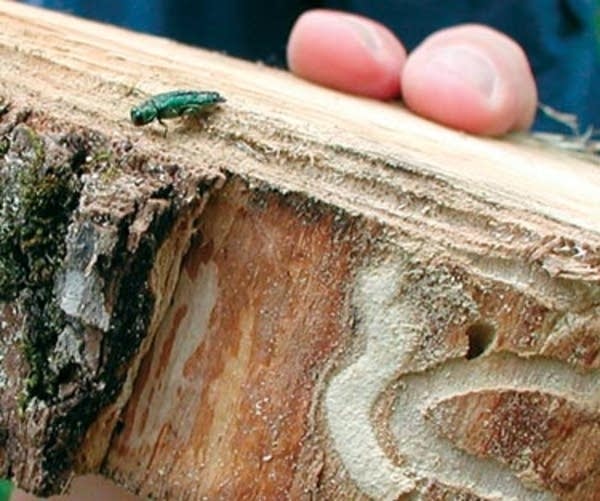Popular urban pesticide under scrutiny

A University of Minnesota scientist is examining potential side effects of the urban use of a popular family of insecticides.
The insecticide is widely used on lawns and gardens and is an effective treatment for emerald ash borer. But it could also be killing beneficial insects like bees.
Insecticides called neonicotinoids were first introduced in the early 1990s. They're different from other insecticides because they are systemic and absorbed by the plant. So if you put a neonicotinoid on your rose bush, when an aphid takes a bite of a leaf, they also get a dose of insecticide.
University of Minnesota entomologist Vera Krischik began to ask questions when she observed the effects of the insecticide in her garden.
Create a More Connected Minnesota
MPR News is your trusted resource for the news you need. With your support, MPR News brings accessible, courageous journalism and authentic conversation to everyone - free of paywalls and barriers. Your gift makes a difference.
"In my own backyard -- when I would buy bedding plants, I noticed queen bumblebees would go in the plant, and then fall down and die," said Krischik. "The only thing I could come up with is there is some systemic insecticide."
Neonicotinoids are regularly applied to ornamental garden plants, Krischik said. The systemic insecticide is also included in many lawn fertilizer blends. The most common, Imidicloprid, is a primary treatment for emerald ash borer infestations.
Krischik said neonicotinoids have replaced most traditional insecticides for urban use, and the urban application rates are much higher than those for farm crops.
"If I use it for a field crop, it's four milligrams per square foot," she said. "If I use it for a rose, it's 300 milligrams per square foot. So you can see, as I go to urban it's much higher consequences than it would be in [agriculture]."

Some European countries have restricted or banned neonicotinoids because of concerns the insecticide is killing bees and contributing to colony collapse in honey bees. The U.S. Environmental Protection Agency is looking at the insecticide as part of its regular registration review process.
It's not clear how much neonicotinoid insecticide is used in urban areas. Data from the Minnesota Department of Agriculture shows about 12,000 pounds were sold in 2008 for urban uses like lawns, gardens and in buildings. Based on the recommended application rate per acre, that's enough to treat about 30,000 acres.
Nila Hines, a pesticide registration review coordinator for the Department of Agriculture, said it's very difficult to track pesticide use in urban areas.
"There is no particular use survey. People, individual researchers have looked at doing surveys here and there, but there's no standard mechanism for surveying use of these compounds in urban environments," she said.
Hines said the agriculture department is closely monitoring the fight against the emerald ash borer, but is not tracking how many trees are treated.
The fight against emerald ash borer is likely to mean an increase in the use of neonicotinoids, especially in the Twin Cities, said Sean Bernick, director of research and development at Twin Cities-based Rainbow Tree Care. He said thousands of trees likely will be treated with the systemic insecticide.

"When used according to the recommendations that are out there, from scientists and following the label, the products will pose a minimal threat to the user, the environment, and they're going to work effectively," Bernick said.
Treating ash trees in urban areas could quickly exceed the recommended maximum rate. Applying Imidicloprid to about three mature trees on five typical city lots would exceed the maximum rate of .4 pounds per acre. The agriculture department is studying the issue and plans to make a recommendation in a couple of weeks.
Bernick points out that ash trees are pollinated by wind, not insects, so pollinators like bees aren't likely to be affected.
Krischik, the U of M researcher, said that's true, but no one has looked at unintended consequences of treating trees with insecticide. She said the Imidicloprid insecticide applied to the soil around a tree will also be picked up by any other plant in the area.
"Every time a dandelion comes up, it's full of Imidicloprid," Krischik said. "What do all the over-wintering insects go to in the spring? They go to the dandelions."
Krischik will be studying just how much insecticide is in plants like dandelions or roses, and how the insecticide accumulates over time. She said preliminary research indicates neonicotinoids persist for several years in woody plants like roses or trees.
She will also try to determine how those insecticide levels affect bumblebees and other insects.
Krischik said the widespread use of such insecticides increases the risk that beneficial insects might be killed. But she said there has been very little research about urban use.
"The potential is huge now because we use higher rates in landscape. It has replaced most of the other compounds in landscape, and you can apply it multiple times," she said. "So it seems like a very important issue, but there has been very limited money."
Krischik has been collecting data for about 10 years, but it wasn't until this year she received enough federal and state funding to launch a comprehensive study.
She hopes to have preliminary results by this fall.
